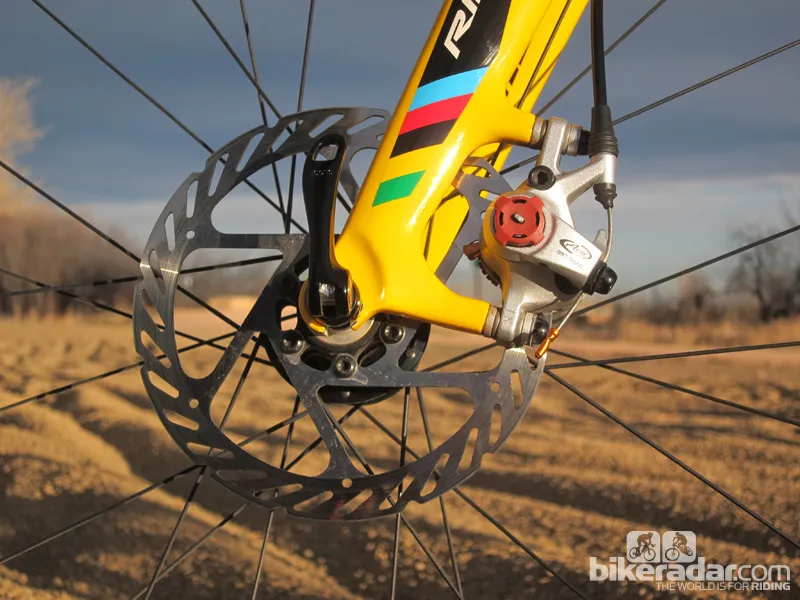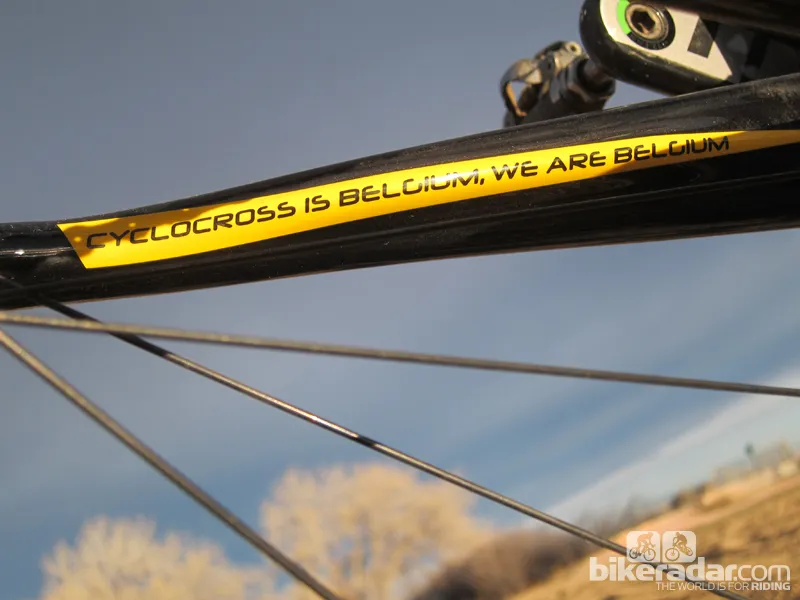A fixture on the North American cyclocross scene since its introduction in 2007, the carbon fiber Ridley X-Fire gets updated yet again for the 2012-13 season, with optional disc brake tabs and 135mm rear hub spacing.
It isn't the lightest, stiffest, or most comfortable machine we've tested but it's a faithful workhorse well suited to nasty conditions.
Ride & handling: Ultra-stable through deep sand but a rough ride
Given Ridley's Belgian roots, it's perhaps no surprise that the X-Fire Disc is brilliant through deep sand (and, presumably, mud, although Colorado's atypically mild winter kept us from testing in those conditions).
The bottom bracket on our 52cm sample drops just 59mm relative to the hub axles – more than 10mm taller than the Specialized CruX, for example – and provides more pedal clearance when your tires and rims are buried in the ground. Moreover, the front end's incredible stability helps you hold your line as you're charging out of the sand and back towards terra firma.
The downside of that tall center of gravity, though, is a somewhat 'tippy' feel plus some reluctance to change direction through successive corners. The front end is also so stable on-center that it doesn't naturally initiate an arc through corners like other bikes we've ridden with more American-style geometry.
Instead, we found it best to aggressively muscle the bars and lean the front end hard in the direction you want to go. The X-Fire will snake through those corners on demand but you need to tell it what to do sternly, not ask.
Get on the gas and the impressively stout X-Fire is more than eager to respond, though, with a rigid front triangle that amply bolsters itself against out-of-saddle handlebar wrestling and a stout rear end that efficiently transmits power from pedal to ground with little mushiness. The fork is a monstrous beast with ample fore-aft stiffness, too, giving the X-Fire a nicely balanced feel front-to-back with both ends behaving similarly when you really start to throw it around.

Ridley equips the X-Fire with stout wishbone-style seat stays
Unlike other high-end carbon 'cross frames that can occasionally feel delicate and fragile, 'sturdy' was the word constantly running through our minds during test rides – as if you could drive straight through into the barriers if you were too lazy to dismount.
"To me, the X-Fire is an awesome race bike," said Boulder Cycle Sport founder – and three-time US cyclocross age category national champion – Brandon Dwight, who graciously loaned us his personal rig for this review. "With the oversized head tube and fork, the front end is so stiff that it does exactly what I want it to. I corner with great confidence."
"It's light, and laterally stiff where it needs to be," he continued. "Plus, it has just enough vertical compliance to make rough races or even long training rides easy on my back and body. The cross-specific geometry is top notch. With the higher bottom bracket I can pedal on more off-camber sections and the larger triangle makes it easy to shoulder."
We found that stiffness unfortunately transfers to the X-Fire's ride quality, though, with a stiff feel that relies almost entirely on the tires to cushion the rider from the ground – quite the opposite from the much smoother-feeling Van Dessel Gin & Trombones and Cannondale SuperX Hi-Mod.
It's tolerable on smoother courses or tracks with softer dirt and/or lots of mud but it definitely beats you up on hardpack and lumpy grass, and the large-diameter 31.6mm seatpost doesn't help. Traction suffers, too, with the X-Fire tending to skitter through loose and bumpy corners while smoother machines we've ridden were more apt to rail through.
Just as Dwight opined, shouldering the X-Fire Disc is a breeze, with its trapezoid-profile down tube fitting neatly in your hand and the slightly flattened and nominally level top tube leaving plenty of room in the main triangle through which to pass your arm.
Mud clearance is very good all round – but not stellar – and there's also more of a shelf on which mud can accumulate behind the bottom bracket than we'd prefer.
Frame: Hardy bones and modern features
Ridley uses up to 60-ton carbon fiber for its ultralight Helium SL road frameset, but that sort of stiffness also comes with brittleness. Instead, the X-Fire Disc uses more forgiving 24-ton fibers for a more balanced blend of rigidity and impact resistance. Given that and the bike's workhorse intentions, it shouldn't come as a surprise that the X-Fire Disc doesn't qualify as an ultralight steed.
Since our test bike was a personal loaner, we didn't see fit to disassemble it for an actual frame and fork weight. However, according to our friends at Competitive Cyclist, a bare frame weighs 1,415g (sorry, frame size unknown) while the matching fork is 480g (uncut steerer, with compression plug).
The geometry might be traditional but Ridley imparts the X-Fire Disc with a host of modern features, including a tapered 1 1/8in to 1 1/2in front end, a press-fit 30 bottom bracket, seat stay-mounted IS disc caliper tabs out back, and post mount tabs on the fork sized for a 160mm rotor.

The girthy down tube fits easily in your hand for run-ups
Cable routing is partially internal, with the rear brake and rear derailleur lines running through the top tube and the one for the front derailleur snaking its way through the down tube, so there's no pulley required.
Housing is full-length throughout, with simple entry and exit ports cut into the tubes. The lack of guides can make maintenance tricky if you're not careful, and the use of high-quality housing is key for good performance and lever feel. On the plus side, the system is also essentially sealed from end to end, so you shouldn't have to do much past the initial build.
For those looking to use an electronic transmission, Ridley conveniently includes wiring ports throughout, although there will be a few vestigial derailleur housing stops and zip-tie guides remaining. As with most disc-equipped 'cross bikes these days, rear dropout spacing is 135mm, so just about any quick-release mountain bike hub or 29er wheelset will fit.
Impressively, Ridley offers the X-Fire in eight sizes, from 41cm all the way up to 60cm, but the traditional geometry will make each one feel bigger than usual. We recommend sizing by stack and reach (or, at the very least, effective top tube length) and don't be surprised if you go down a size or two from your usual dimensions.
Equipment: Cross-friendly SRAM Force bits, powerful brakes, and brilliant tubeless setup
Ridley offers the X-Fire Disc as a bare frameset (US$1,595 / £1,190) or a complete bike with Shimano Ultegra (US$3,395.99 / £2,290) or SRAM Apex components.
As our tester was a personal rig, it was instead a custom build featuring a SRAM Force transmission, SRAM S900 carbon cranks, Avid BB7 Road disc brakes with G2-style rotors, Stan's NoTubes Iron Cross tubeless aluminum clinchers shod with Clement LAS semi-slicks, and finishing kit from Ritchey and Fizik. Total weight without pedals was 7.97kg (17.57lb).
As we've noted on numerous occasions before, SRAM's second-tier Force group is an outstanding pick for the rough and tumble of 'cross racing, with precise front and rear shift performance, very positive and feedback-laden shifter action, and – at least compared to the top-end Red – fairly reasonable component replacement costs.
Tightly spaced 46/49T chainrings make for reliable chain movement up front, too, although if things go south there's the option for SRAM's latest Red bolt-on chain catcher, which was installed here.

The SRAM Force group is a good high-end option for cyclocross
Braking performance was fantastic, with outstanding lever feel, excellent initial bite, and easily controllable modulation, even with the semi-slick tires mounted. As always with Avid's long-running mechanical disc calipers, careful setup is key – and it's worth noting that this particular tune was among the best we've encountered, with an exceptionally firm and positive lever feel, low-friction action, and snappy return.
We weren't able to test this bike in wet conditions but prior experience has shown the advantages of disc brakes over cantilevers to only grow, with far less degradation in performance (provided the conditions aren't so abrasive as to excessively wear the pads).
This test does, however, mark another tubeless data point for Stan's wheels and Clement rubber. While heavier and/or more aggressive riders might find the Iron Cross wheelset a touch soft, the tight fit allowed us to reliably run just 25/27psi front/rear under a 70kg test rider with no burping to speak of even on fast race courses with excellent grip and tight corners.
Racers who regularly compete in UCI-sanctioned events should know that the wide rim and low bead hook balloons the already-wide Clement tires well past the 33mm maximum width so choose your treads wisely if that's a concern. Otherwise, the added volume is fantastic for training and local events.
Adding to the bike's monolithic feel was the Ritchey WCS Evo Curve aluminum bar and WCS 4-Axis forged aluminum stem. Both bits are reasonably light but with a stiffer and more direct feel than some carbon fiber cockpits we've used, plus they're less prone to catastrophic crash damage than composite pieces.
Likewise, the Ritchey 1-Bolt seatpost held firm even on sloppy remounts, and the admirably trim design leaves plenty of room for low-profile saddles.















